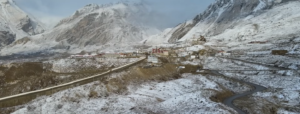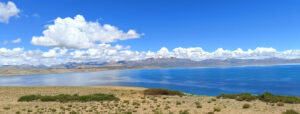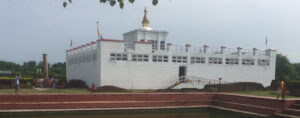The Kailash Mansarovar Yatra is a pilgrimage to Mount Kailash and Lake Mansarovar in the Tibetan Plateau. Mount Kailash is revered by Hindus, Buddhists, Jains, and followers of the Bon religion. Hindus regard it as the home of Lord Shiva. Buddhists worship it as the home of Demchok. Jains consider it the place where their first Tirthankara found emancipation. Bon followers regard it as a place of enormous power.
Lake Mansarovar, situated near the mountains, is renowned for its peaceful, crystal-clear waters. Pilgrims in large numbers make the Kailash Mansarovar Yatra annually for blessings and spiritual comfort. This guide contains routes, permits, travel tips, fitness advice, and the best visiting time. For spirituality or adventure, the yatra holds deep meaning and beauty. Plan, and this trip will be one of the most memorable experiences of your life.
Spiritual Significance of Mount Kailash
Mount Kailash holds deep spiritual meaning across several ancient religions. In Hinduism, it is believed to be the abode of Lord Shiva, the god of transformation and destruction. Devotees see Mount Kailash as the center of the universe and a source of divine energy. Praying or meditating here can cleanse the soul and bring spiritual growth.
Nearby Lake Mansarovar is considered one of the holiest lakes in the world. Its clear, calm waters are believed to purify sins and bless pilgrims with peace. Bathing in the lake or touching its water is seen as spiritually powerful. The Kora, or circumambulation of Mount Kailash, is a sacred ritual. Walking the 52-kilometer path around the mountain symbolizes shedding one’s ego and past sins. Completing the Kora is said to bring immense spiritual merit and inner transformation.
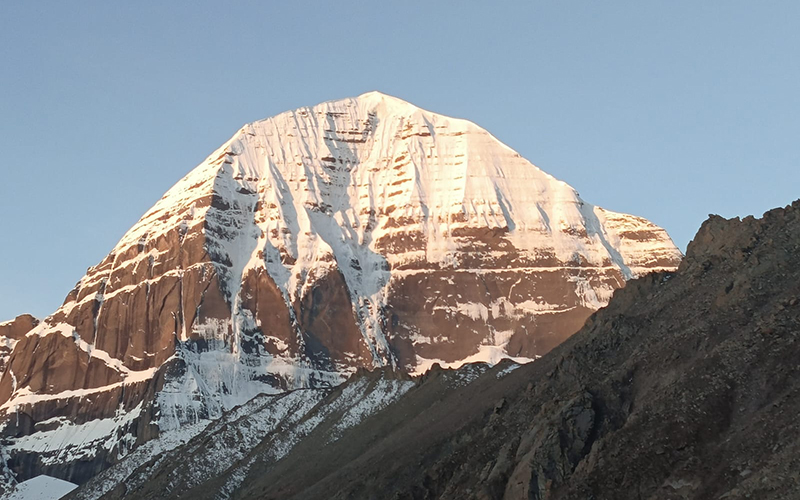
Best Time to Visit Kailash Mansarovar
Planning a visit to Kailash Mansarovar is not just picking a date—it’s a fine balance of choosing the perfect mix of weather, festivals, and religious significance. Here’s what you should know to make the most suitable choice for this lifetime journey.
Ideal Travel Months: May to September
The best time to visit Kailash Mansarovar is from May to September. The climate is more stable during these months, and the high-altitude terrain becomes accessible.
- May & June: Snow begins to melt, revealing green valleys and offering breathtaking views of Mount Kailash. Cold weather, but ideal for trekking.
- July & August: These are the warmer months, although they are accompanied by occasional rain, mostly on the Nepal side. However, the majority of itineraries remain accessible, and the scenery is lush and green.
- September: The weather becomes clear again, and it is a great time to travel if you prefer fewer crowds and crisp mountain air.
- Note: Avoid traveling between October and April, as the region experiences heavy snowfall, road closures, and low temperatures.
Festival Timings to Consider for Kailash Mansarovar Yatra
If you’re planning a trip to Kailash Mansarovar, timing your journey with important festivals can make your experience even more meaningful. Here are two special occasions that draw thousands of pilgrims every year:
Saga Dawa Festival (May or June)
One of the most sacred and spiritual times to visit Mount Kailash is during the Saga Dawa Festival. It celebrates three very important incidents in the life of Lord Buddha — his birth, enlightenment, and death — all of which are believed to have happened on the full moon of the month.
- Thousands of devotees from across the world gather to perform the ritual Kora (circumambulation) around Mount Kailash.
- A grand ceremony is held at Tarpa Chorten, where a tall prayer flagpole is replaced in a traditional and symbolic ritual.
- The atmosphere is filled with chanting, prayer flags, and the deep devotion of the pilgrims, creating a powerful spiritual energy.
Full Moon (Purnima)
Many pilgrims plan their journey during the Full Moon (Purnima) because it holds deep religious and spiritual meaning.
- At the time of the full moon, the view of Mount Kailash and Lake Mansarovar is even more magical. The white-topped mountains and peaceful water in the light of the moon create a calm and divine environment.
- Doing the Kora during a full moon is believed to bring greater blessings and spiritual benefits.
- The peaceful silence under the moonlit sky adds a mystical touch to the entire experience.
| Month | Weather | Highlights | Crowds |
| May | Clear, cool | Saga Dawa Festival, snowmelt views | Moderate–High |
| June | Mild, stable | Best trekking weather, scenic landscapes | Moderate |
| July | Warm, chance of showers | Full Moon, green valleys, spiritual vibe | High |
| August | Monsoon effects possible | Rich scenery, spiritual festivals | High |
| September | Crisp, post-monsoon | Clear skies, peaceful trekking | Moderate |
Kailash Yatra Routes
As of 2025, there are two operational routes to embark on the sacred Kailash Mansarovar Yatra—both starting from Kathmandu, Nepal. The pilgrims can take either the Overland Route via Kerung, which offers a scenic road journey through the Himalayas with gradual height increases, or the Helicopter Route via Simikot, which includes flights and short helicopter hops to cover the distance in less time and more comfort.
Both routes are fully functional and well-suited for different travel needs, whether you’re seeking a traditional pilgrimage experience or a faster, more convenient journey.
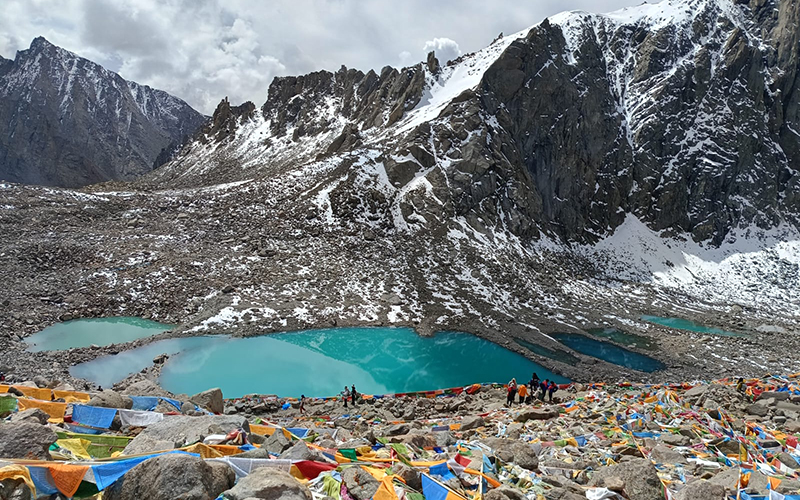
Overland Route via Kerung (Kathmandu – Rasuwagadhi – Kerung – Kailash)
- Status: Open and Operational
- Travel Type: Road journey through Nepal into Tibet
- Start Point: Kathmandu, Nepal
- Border Crossing: Rasuwagadhi (Nepal) – Kerung (Tibet)
- Ideal For: Pilgrims seeking a more scenic and traditional journey with gradual altitude gain
Helicopter Route via Simikot (Kathmandu – Nepalgunj – Simikot – Hilsa – Kailash)
- Status: Open and Operational
- Travel Type: Combination of flight, helicopter, and road
- Start Point: Kathmandu, Nepal
- Route: Kathmandu → Nepalgunj (flight) → Simikot (flight) → Hilsa (helicopter) → cross into Tibet by foot → drive to Kailash
- Ideal For: Elderly pilgrims or those short on time
How to Reach Kailash Mansarovar from the USA/India
Visiting Kailash Mansarovar from India or the USA requires careful planning. The easiest and most used route is via Nepal, where Kathmandu is the main entry point.
If you’re traveling from the USA, you will have a one or two-stop flight to Kathmandu – typically through Doha, Istanbul, Abu Dhabi, Delhi, or Singapore. There are no direct flights from the USA to Nepal. From India, there are direct daily flights to Kathmandu from Delhi, Mumbai, Varanasi, and Kolkata.
After arriving in Kathmandu, there are two main options for reaching Kailash Mansarovar. The Overland Route via Kerung is a picturesque road trip from Kathmandu to the Nepal-Tibet border at Rasuwagadhi, to enter Kerung, and then continue driving to Kailash. This road offers the opportunity for gradual altitude acclimatization and beautiful views of the Himalayas.
The Helicopter Route via Simikot and Hilsa integrates flying and a helicopter trip to the border. It is quick and ideal for travelers with restricted time or who require limited walking. Either route provides incredible spiritual journeys with magnificent scenery. Choose the route most appropriate for your time and comfort.
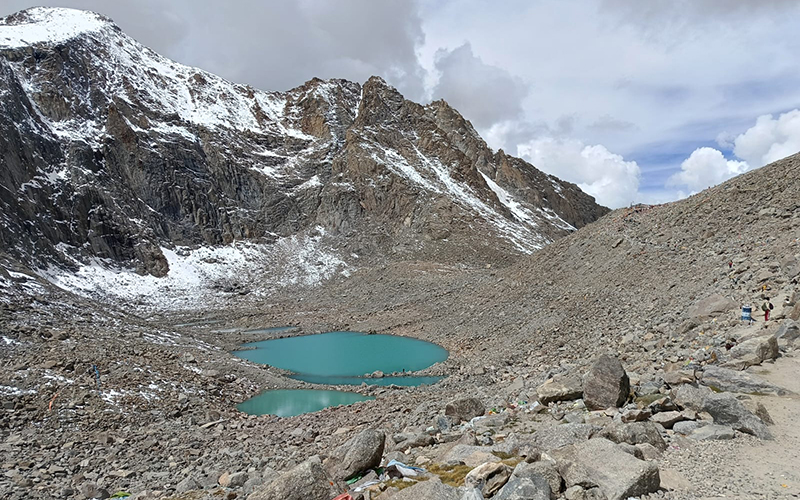
Permits and Visa Requirements
Kailash Mansarovar is in the restricted Tibet Autonomous Region, so traveling to it requires special permits and visas. The permits and visas are legal documents that will allow you to enter the area legally (and get out!) and travel smoothly within the area.
Different permits and visa rules depend on whether the traveler is an Indian or a foreign national, and travel must be done in a group. Knowing the requirements for travel helps you prepare for the pilgrimage without problems.
Chinese Group Visa and Tibet Travel Permit
All travelers must have a Chinese Group Visa and a Tibet Travel Permit to go on a pilgrimage to Kailash Mansarovar. A Chinese Group Visa is not the same as a regular visa. A Chinese Group Visa is issued for groups booked with travel companies that are authorized to run tours.
A Tibet Travel Permit must be obtained for traveling into the Tibet Autonomous Region, which is where Kailash is located. Each of these permits allows access to restricted areas, and both permits must be held by tourists and pilgrims alike.
Indian Passport Holders vs Foreign Nationals
Traveling to Kailash Mansarovar is more complicated for Indian passport holders than for foreign passport holders. Indian passport holders must get special permits from the Indian government, and have border restrictions that must be followed.
Foreign passport holders are required to travel as part of an approved tour group and company with a registered operator and are not allowed to travel to Tibet independently. These important differences need to be taken into consideration when planning your trip.
Travel Restrictions and Group Travel Rules
Solo travel to Kailash Mansarovar is prohibited for security and regulatory reasons. All travelers must join a group tour authorized by the relevant Chinese authorities. The need for group travel helps to reduce the environmental impact and also protects the pilgrims in this very remote area. While travel restrictions can change for several reasons, including political or weather changes, it is important to be aware of this in preparing a trek and book your trek through proper and authorized agencies.
Kailash Mansarovar Yatra Cost
he cost of the Kailash Mansarovar Yatra depends on the route you choose and the services included. On average, the yatra costs range from USD 2,500 to USD 5,000 per person.
Cost by Route
Overland Route via Kerung (Kathmandu–Rasuwagadhi–Kerung–Kailash)
- Duration: Approximately 14 days
- Cost: USD 2,500 – USD 3,200 per person
Includes:
- Transportation (bus/jeep)
- Accommodation
- Meals
- Permits and Chinese group visa
- Guide and logistics support
Helicopter Route via Simikot – Hilsa – Kailash
- Duration: Approximately 10–12 days
- Cost: USD 3,800 – USD 5,200 per person
Includes:
- Flights (Kathmandu–Nepalgunj–Simikot)
- Helicopter to Hilsa
- Permits and Chinese group visa
- Accommodation and meals
- Guide and full support
Optional Costs
- Pony and personal porter during the Kailash Parikrama: Approximately USD 500 – USD 600 per person
- Travel insurance: Highly recommended but not included in most packages
- Tips for guides and staff
- Personal expenses: Snacks, donations, shopping, etc
Note: Prices may vary depending on the operator, group size, hotel standards in Kathmandu, and additional services like oxygen cylinders or VIP arrangements.
Packing List & Health Precautions for Kailash Mansarovar Yatra
Preparing well for your Kailash Mansarovar Yatra is key to a safe and smooth journey: the high altitude, cold weather, and remote terrain demand proper gear and health precautions.
Essentials for High-Altitude Trekking
- Pack light but smart. Here are the must-haves:
- Warm layered clothing (thermal innerwear, down jacket, windproof outer shell)
- Comfortable trekking shoes with a good grip
- Woolen gloves, cap, and socks
- Sunglasses and sunscreen for UV protection
- Reusable water bottle and purification tablets
- Personal medications and a basic first aid kit
- Trekking poles, a headlamp, and energy snacks are also useful
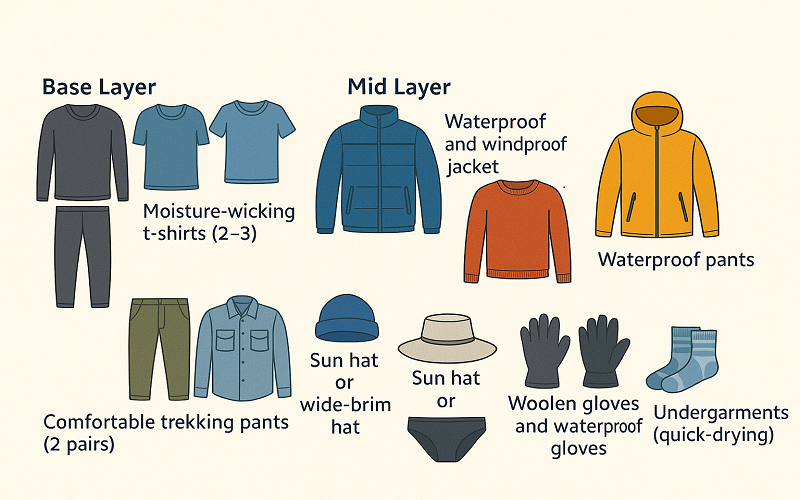
Acclimatization Advice
Allow your body enough time to acclimate to the altitude. Take a couple of days in either Kathmandu or Kerung before going to higher elevations. Stay hydrated, avoid alcohol, and walk slowly and steadily. Remember that altitude sickness can affect anyone, so you should tell your guide right away if you notice symptoms such as headaches, nausea, and/or shortness of breath.
Travel Insurance
It is mandatory to have travel insurance for the yatra, and you should include coverage for high-altitude trekking, medical emergencies, evacuation, and cancellation. Always take a copy of your insurance, passport, and emergency contact details.
Tips for First-Time Hindu Pilgrims
The Kailash Mansarovar Yatra is a lifetime spiritual journey for many Hindus. If you are going for the first time, it is helpful to know some of the important practices related to the journey and the expected respectful behavior while undertaking the pilgrimage.
Ritual Practices at Mansarovar
1. Holy Bath: Pilgrims often take a dip in Lake Mansarovar. It is believed to purify the soul and cleanse past sins. However, avoid full immersion if the water is too cold or if you’re unwell.
2. Puja and Prayers: You may offer water, flowers, or incense to Lord Shiva. Many pilgrims also perform meditation or chant mantras near the lake.
Dos and Don’ts for the Yatra
Do’s:
- Walk slowly and stay hydrated
- Follow your guide’s instructions
- Carry your spiritual items respectfully
Don’ts:
- Avoid loud music, shouting, or selfies at sacred spots
- Do not litter — keep the area clean
- Avoid alcohol, smoking, or non-vegetarian food during the yatra
The Kora around Mount Kailash is a sacred walk, undertaken as a practice for prayer and devotion. It is more than a physical walk — every step is a spiritual step. Remember to always walk in a clockwise direction and remain calm and respectful. It is also good to remain quiet or use some mantras while you walk.
Do not point at the mountain. Do not take candid pictures. Be respectful and give way to the people who are practicing their prostrations, as this is a form of worship. Do not sit with your feet towards the mountain, and do not disturb/ sit in prayer spaces created by other practitioners. Be humble and treat the entire walk as a sacred experience.
Frequently Asked Questions about Kailash Yatra
1. How Challenging Is the Kailash Parikrama (Kora Trek)?
The Mount Kailash Kora trek is moderately to highly challenging due to the high altitude, reaching up to 5,630 meters (18,471 feet) at Dolma La Pass. Proper acclimatization, physical fitness, and mental preparedness are crucial for completing this spiritual 3-day trek.
2. Is Kailash Mansarovar Yatra Safe for Senior Citizens?
Yes, the Kailash Yatra for senior citizens is possible with medical clearance, careful planning, and support. Most Kailash tour operators provide pony or porter assistance to help elderly pilgrims complete the journey safely and comfortably.
3. How Many Days Does the Kailash Mansarovar Yatra Take?
The duration of the Kailash Yatra typically ranges from 10 to 14 days, depending on the chosen route—whether via Nepal, Tibet (China), or India. This includes travel time, acclimatization days, and the Kailash Parikrama.
4. Can I Travel to Kailash Mansarovar Without a Group Tour?
No. Independent travel to Mount Kailash is not permitted. All pilgrims must book through a licensed tour operator like Asia Heritage Treks and Travel, which will arrange the Chinese visa, Tibet Travel Permit, and all logistics.
5. What Is the Cost of the Kailash Mansarovar Yatra?
The cost of the Kailash Yatra ranges between $2,500 and $5,000, depending on the route, travel season, and level of service. Packages usually include permits, accommodation, meals, local transport, and guide support.
6. Why Is the Full Moon Yatra to Kailash Considered Special?
A Kailash Yatra during the Full Moon is believed to be spiritually more powerful. Many Hindu pilgrims choose Full Moon departures for enhanced blessings during the Parikrama (Kora) around Mount Kailash.
Is Travel Insurance Required for Kailash Mansarovar Yatra?
Yes, travel insurance for Kailash Yatra is strongly recommended. It should cover high-altitude trekking, medical emergencies, and helicopter evacuation in remote Himalayan regions.
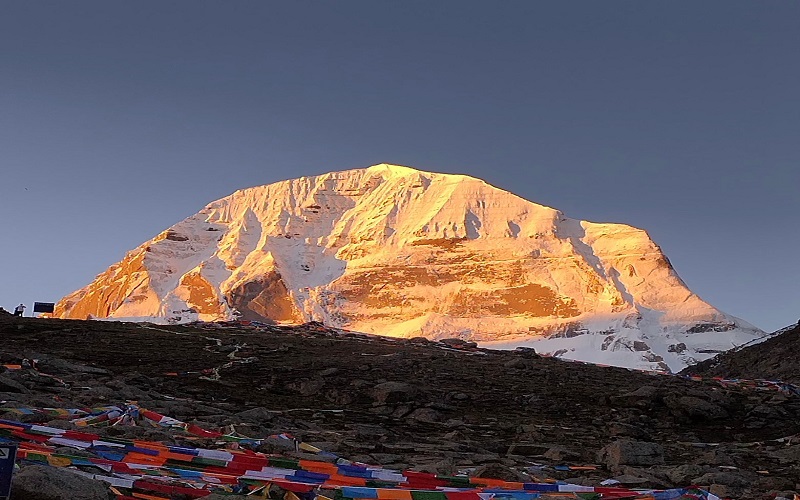
Conclusion
The Kailash Mansarovar Yatra isn’t just another trip; it’s a profound spiritual adventure that offers peace, clarity, and a deep sense of devotion. With the right planning, choosing the best season, and working with a reliable travel operator, you can ensure that your experience is safe, smooth, and truly transformative.
Take each step with faith, patience, and gratitude. May Lord Shiva guide and bless you throughout this sacred journey to Kailash.
Let our expert team at Asian Heritage Treks and Travel take care of everything — from guided tours to personalized packing tips and travel arrangements.
Plan My Kailash Trip




